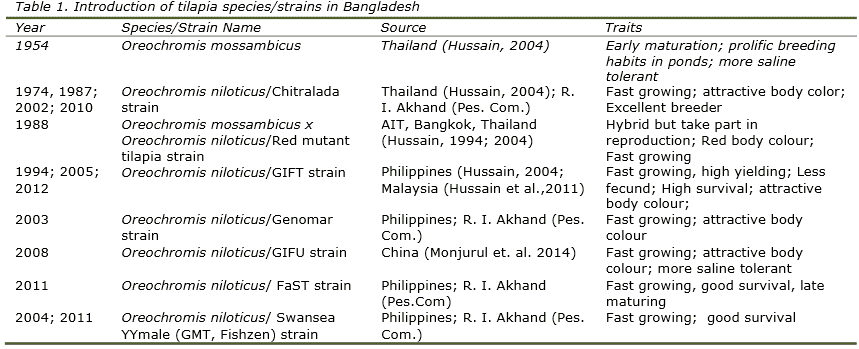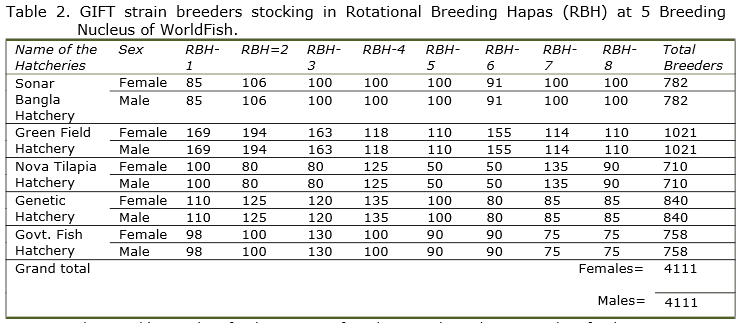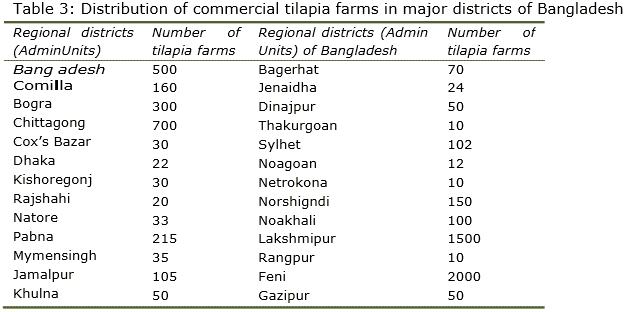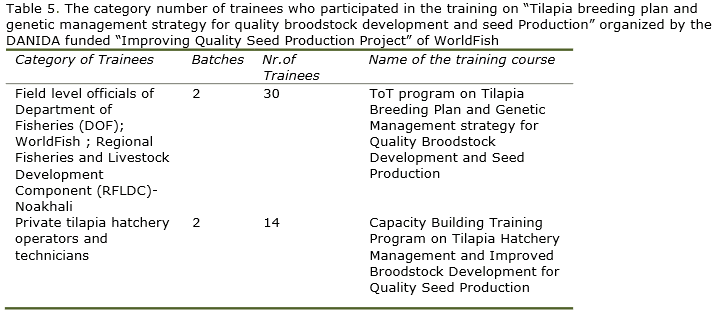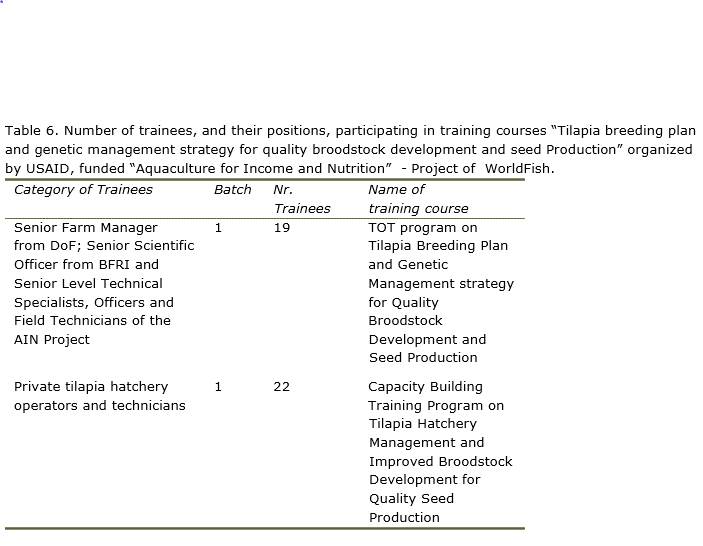Total world tilapia production in 2010 was 3.70 million tons. According to the Fishery Statistical Yearbook of Bangladesh, tilapia production was 136,000 metric tons in 2012. Tilapia is predicted to be the primary cultured species in different water ecosystems in Bangladesh (Hussain, 2004).
In Bangladesh, freshwater aquaculture systems revolve mainly around the polyculture of various carp species (both Indian and Chinese) in varying combinations and densities, depending on the availability of seed. Progressive farmers and entrepreneurs have been seeking alternative species, to maximize production and profit. Tilapia is a prime candidate and extensive tilapia farming in Bangladesh has developed with the introduction of the improved Oreochromis niloticus i.e. Genetically Improved Farmed Tilapia (GIFT) strain, provided in 1994 by WorldFish (formerly ICLARM) under the Dissemination and Evaluation of Genetically Improved Tilapia in Asia (DEGITA) project and the development of further genetically improved strains by the Bangladesh Fisheries Research Institute (BFRI). This was followed by dissemination of these strains at low cost and the adoption of
appropriate aquaculture technologies by producers. Tilapia farming in Bangladesh has progressed and production increased more than fivefold between 2005-2010.
Introduction of Tilapia to Bangladesh. Mozambique tilapia, O. mossambicus was the first species to be introduced into Bangladesh from Thailand in 1954 (Hussain,2004). The fish however proved to be a pest due to early maturation and prolific breeding habits in the ponds. In 1974, the Chitralada strain of Nile tilapia, a promising farmed species, was introduced into Bangladesh from Thailand through UNICEF. The Bangladesh Fisheries Research Institute (BFRI) initiated the second introduction of tilapia to Bangladesh, also from Thailand, in 1987 (Hussain, 2004). Subsequently, the red mutant tilapia strain i.e. the hybrid between albino O. mossambicus x O. niloticus, the GIFT strain, and further introduction of Chitralada strain of Nile tilapia were made. A number of other tilapia strains, Genomar, GIFO, FaST, and Swansea YYmale/GMT (Fishgen) have been introduced by private sector hatcheries and entrepreneurs in Bangladesh (Table 1), but none of these strains has been able to make significant contributions in terms of quality broodstock development, seed production, and aquaculture farming.
Stock Improvement of GIFT and Red Tilapia Strains
Stock Improvement of GIFT strain. The GIFT strain was developed by WorldFish through several generations of selection from a base population involving eight different strains of Nile tilapia (Eknath et al. 1993). BFRI received the first batch of GIFT strain tilapia in 1994, and 116 families of the same strain in 1996. The on-station and on-farm trials conducted by BFRI, resulted in a 35-57% improvement in growth performance for the GIFT strain compared to existing local strains (Hussain et al. 2000).
Further stock improvement of GIFT using mass selection techniques was initiated in 1998 and continued until 2004. Six generations were produced, the sixth (F6) had a 32.66% higher growth than the original GIFT strain. Fish weight gain increased up to the third generation after which it gradually decreased. Increased inbreeding may have accounted for the declining trend in genetic gain in particularly for body weight. According to the WorldFish Center (2004) report, after several generations, selected breeding candidates from the applied mass selection method can lead to inbreeding. If large families are naturally produced or stocked in the test environment the wide genetic variation and common non-genetic effects (e.g. maternal and age effects) may easily result in a disproportionately high contribution from just a few parents to the next generation and a consequent increase in inbreeding. Such inbreeding reduces the genetic variation and potential for further genetic improvement in the breeding population (WorldFish Center, 2004).
In 2005 a genetic improvement strategy (Malaysia) of family selection protocol of the GIFT strain was implemented (Hussain et al. 2011). Six generations were developed from 2008–2012 through family selection (14th generation of GIFT strain) resulting in 39.25% greater individual weight than that of the founder population (Kohinoor et al 2013).
Due to excellent performance for growth and traits such as survival, fecundity, and disease resistance etc. the newly improved strain has been renamed BFRI Super GIFT strain. Presently BFRI, a center of excellence for genetic improvement of the GIFT strain, distributes more than 1.0 million improved tilapia broodstock every year to 200 tilapia hatcheries throughout the country.
Development of true breeding red tilapia. The stocks introduced in 1988 (Thai red strain) were not true breeding stocks (Hussain, 1994). The World Fish Center brought a new batch of red tilapia strain to Bangladesh in 2005. These were progeny tested at BFRI using Mendelian Test Cross techniques. Malaysian red strain produced 100% all red progeny. Currently, BFRI has further improved this strain using the cohort or rotational selective breeding technique, where the best selected red tilapia male broodstock of each cohort was mated with the female broodstock of another cohort in each generation. As a result of out-breeding, there is no danger of stock deterioration. In every generation, a certain degree of additive genetic gain occurs resulting in genetically improved broodstock for quality seed production. This program was initiated for mass seed production for distribution and dissemination of breeding and culture techniques to farmers and entrepreneurs.
Establishment of tilapia breeding nucleus by WorldFish. Genetic deterioration of broodstock through poor hatchery management has been considered the main reason for deterioration of quality seed production in tilapia. WorldFish (Asia), has therefore established five "Tilapia Breeding Nucleus (TBN)” through projects like RFLDC-DANIDA project, CSISA-BD project, and the USAID funded Aquaculture for Income and Nutrition (AIN) Project, in public and private sector hatcheries for the production and dissemination of improved broodstock of tilapia (Hussain and Barman, 2013). It is the first time that WorldFish has established five TBNs" under these projects in Bangladesh using 14th generation improved base population of GIFT strains collected both from BFRI, Bangladesh, and Jitra Station, Malaysia. Among these five TBNs; two have been established under the RFLDC/DANIDA Project, one at Green Field Hatchery, Laxmipur and another at Sonar Bangla Hatchery, Bamna, Barguna. Another has been established by the CSISA-BD Project at Nova Tilapia Hatchery, Tarkanda, Mymensingh, and two more have been established by the Aquaculture for Income and Nutrition (AIN) Project one at Govt. Fish Farm, Base Para, Jessore and another at Genetic Hatchery, Noapara, Jessore. Both selective breeding and rotational breeding techniques are being applied in all the TBNs for high performing tilapia strain development (Table 2).
It is expected that these TBNs will be able to produce more than 4 million improved tilapia germplasm each year for distribution and sale. Further establishment of a number of Tilapia Satellite Hatcheries (TSH) throughout the country are planned, to produce high yielding breeding stock using improved quality broodstock from the TBNs for selling/distribution to targeted multipliers. Selected public and private hatcheries will act as multipliers for dissemination of high quality broodstock adapting them to a wide range of tilapia farming systems of the many grow-out farmers in the country (Fig. 1).

Development of Commercial Tilapia Hatcheries and Farms
Production of all male monosex tilapia. Optimal hormone dose for the production of monosex all male GIFT seed production was administered for mass seed production. Subsequently the sex reversal technique has been disseminated to public and private hatchery operators and presently more than 400 tilapia monosex all male seed hatcheries have been established in Bangladesh. These hatcheries produce over 4.0 billion monosex (male) fry every year.
Land based tilapia farms. Over 6000 medium and large scale commercial farms involved in production of grow-out table size tilapia were established between the years 2000–2012 (Table 3).
The average farm size is 1.0 ha, containing about 20 ponds. More than 90% of the grow-out farmers stock their ponds with monosex BFRI super GIFT strain at 70,000 fish/ha (Dr. Kohinoor pers. com.) About 500 other farms, raise monosex and mixed sex tilapias with riverine catfish, Pangasius sp., species. Commercial farms produce about 136,000 metric tons of marketable size tilapia of 150-300 g (Figure 2). In most local markets fish are marketed fresh but in chain super markets they are sold
chilled. Tilapia comprises about 12.5% of total aquaculture production in Bangladesh.
Tilapia cage culture. The Bangladesh Fisheries Development Corporation (BFDC) pioneered experimental cage culture of Nile tilapia in Kaptai Lake, Rangamati in the 1980s. However, no production data is available. A number of private entrepreneurs initiated tilapia cage culture in the Dhakatia river near Chandpur and Munshiganj region. In their operation, the stocking density varied from 200-350 fish/m3. After 8- 9 months of culture, production ranged from 120 to 190 kg/m3, with a feed conversion ratio of around 2.00.
Tilapia cage culture is gaining popularity. BRAC, an internationally reputed non- governmental organization, operates experimental cage farming in various parts of Tilapia farming in Bangladesh in collaboration with the Ministry of Fisheries and Livestock, Government
of Bangladesh.
Tilapia in irrigation ponds in tea gardens. Bodies of water on tea estates are an avenue of tilapia farming in Bangladesh. In Bangladesh there are about 163 tea gardens covering approximately 140,000 hectares. Each tea estate consists of more than 30 hectares of water bodies, mainly used for irrigation purposes during the summer. From 2006 to 2010, sixteen estates initiated commercial farming of monosex tilapia. These tea estates produce an average of 9000 metric tons of monosex tilapia per year.
Technology dissemination and training
Training organized by BFRI. In order to disseminate appropriate technologies of BFRI GIFT, 50 government hatchery managers, more than 400 private hatchery managers, and entrepreneurs were trained in monosex hatchery management systems, broodstock replacement protocols, and implementation of simple breeding plans etc. In addition, 3000 progressive fish farmers were trained on the improved BFRI GIFT strain all male monosex culture (Table 4).
Training organized by WorldFish. Several 2 day, "Training for Trainers" (ToT) programs were organized and conducted by DANIDA, USAID, and WorldFish, on “Tilapia Breeding Plan, Genetic Management strategy for Quality Broodstock Development and Seed Production” for field level scientists, officers, and other technical staff (tables 5 & 6).
The future of tilapia seed production and farming
WorldFish has established five "Tilapia Breeding Nucleus (TBN)" hatcheries in Bangladesh in the public and private sector. It is estimated that during the breeding season of 2013 these five TBNs would be able to produce over 3 million improved tilapia broodstock to be distributed/sold among 100 tilapia hatcheries to fill the demand for improved, high quality, tilapia broodstock. From 2014 onwards, the production of improved broodstock in these TBNs may double or even triple to meet the demand of tilapia broodstock required for production of 10.2 million fry per year. Bangladesh abounds with hundreds and thousands of seasonal water bodies in the form of ditches, shallow ponds, road side canals, and borrow pits (an excavated area where material has been dug out for use as fill at another location). These water bodies have tremendous potential for aquaculture. Their suitability for culturing fish species with a short life cycle, fast growth rate, and low input support requirements, make tilapia a promising candidate for aquaculture in the suitable seasonal water bodies (Hussain et al. 2000). In addition, in brackish water zones and coastal farms (0.20 million ha) of the country, where extensive shrimp culture is practiced, commercial farming of tilapia may be an alternative when salinity is too low for shrimp culture.
Conclusion
Tilapia farming has great potential in Bangladesh. Tilapia promises to become a primary cultured species for freshwater and brackish water ecosystems, and therefore may also be a major source of employment. Bangladesh could become one of the leading Asian countries for tilapia seed production and grow-out farming.
June 2014

